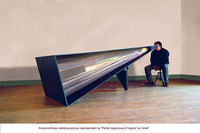User:Dimitri Parant: Difference between revisions
imported>Dimitri Parant No edit summary |
No edit summary |
||
| (16 intermediate revisions by one other user not shown) | |||
| Line 1: | Line 1: | ||
I am french artist and I am passionate about optical art. I'm working on three new pictorial concepts: | {{AccountNotLive}} | ||
I | I am french artist and I am passionate about optical art. I'm working on three new pictorial concepts: The anaglyph painting, the stereoscopic anamorphosis and the afterimage in painting. I want to start an article on the afterimages that we can see with eyes closed, hence the philosophical interest in my approach. | ||
[[Category:CZ Authors|Parant, Dimitri]][[Category:Visual Arts Authors|Parant, Dimitri]] | |||
{{DEFAULTSORT:Parant, Dimitri}} | |||
{{Image | Dimitri Parant Serge Gainsbourg.jpg | right | 200px |. Afterimage painting. Concentrate 30 seconds on the white dot and close your eyes 10 seconds.}} | |||
==The [[afterimage]] in [[painting]]:== | |||
*Definition "[[Afterimage]]" or "[[Remanence]]": | |||
Property of a sensation, in particular a visual one, that remains after the disappearance of the [[stimulus]]. | |||
A [[stimulus]] is a factor that has an effect on a cell, on an organ, on the organism, causing a muscular or nervous response. | |||
This art relies on the phenomenon of [[retinal persistence]], which allows the brain to "virtualize" [[paintings]] "in positive" and see what they represent when looked at on a very contrasted surface. | |||
Click on the [[picture]], concentrate on the small white dot for 30 seconds and keep your eyes fixed on a plain surface (for example: a white wall) for 10 seconds, or simply close your eyes for 10 seconds. | |||
Your mind, by the use of "[[afterimage]]", will reveal the face of the person on the portrait. | |||
{{Image | Dimitri Parant Anamorphose.jpg | right | | |||
{{Image | Dimitri Parant Anamorphose.jpg | right | 200px |. Stereoscopic anamorphosis}} | |||
==[[The stereoscopic anamorphosis]]:== | |||
*Definition [[Anamorphosis]]: | |||
An [[anamorphosis]] is a deliberately distorted image which regains its normal aspect either when seen under a certain angle or through conical, cylindrical or distorting [[mirrors]]. | |||
[[Anamorphosis]] proceeds from the inversion of elements and functions. Instead of progressive reduction of their visible limits, it consists of some [[dilatation]], some kind of projection of forms, meant for themselves to be naturally reconstructed under a certain angle of view: some kind of destruction in [[view]] of reconstruction, a sort of escape which implies some sort of backlash. The process itself could eventually be viewed as a technical curiosity only, but anyhow, it surely holds some [[poetic]] [[abstraction]], some powerful optical mechanisms and somewhere the [[philosophy]] of [[artificial]] [[reality]]. | |||
{{Image | Dimitri Parant Anaglyph.jpg | right | 350px |. Anaglyph painting}} | |||
==[[The anaglyph]] with the [[painting]]:== | |||
*Definition [[Anaglyph]]: | |||
An [[anaglyph]] is a [[photographic]] process that can see a [[stereoscopic image]] through red and green filters. | |||
Latest revision as of 03:46, 22 November 2023
The account of this former contributor was not re-activated after the server upgrade of March 2022.
I am french artist and I am passionate about optical art. I'm working on three new pictorial concepts: The anaglyph painting, the stereoscopic anamorphosis and the afterimage in painting. I want to start an article on the afterimages that we can see with eyes closed, hence the philosophical interest in my approach.
The afterimage in painting:
- Definition "Afterimage" or "Remanence":
Property of a sensation, in particular a visual one, that remains after the disappearance of the stimulus. A stimulus is a factor that has an effect on a cell, on an organ, on the organism, causing a muscular or nervous response. This art relies on the phenomenon of retinal persistence, which allows the brain to "virtualize" paintings "in positive" and see what they represent when looked at on a very contrasted surface. Click on the picture, concentrate on the small white dot for 30 seconds and keep your eyes fixed on a plain surface (for example: a white wall) for 10 seconds, or simply close your eyes for 10 seconds. Your mind, by the use of "afterimage", will reveal the face of the person on the portrait.
The stereoscopic anamorphosis:
- Definition Anamorphosis:
An anamorphosis is a deliberately distorted image which regains its normal aspect either when seen under a certain angle or through conical, cylindrical or distorting mirrors.
Anamorphosis proceeds from the inversion of elements and functions. Instead of progressive reduction of their visible limits, it consists of some dilatation, some kind of projection of forms, meant for themselves to be naturally reconstructed under a certain angle of view: some kind of destruction in view of reconstruction, a sort of escape which implies some sort of backlash. The process itself could eventually be viewed as a technical curiosity only, but anyhow, it surely holds some poetic abstraction, some powerful optical mechanisms and somewhere the philosophy of artificial reality.
The anaglyph with the painting:
- Definition Anaglyph:
An anaglyph is a photographic process that can see a stereoscopic image through red and green filters.


